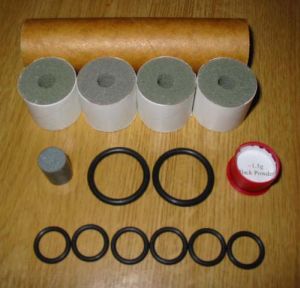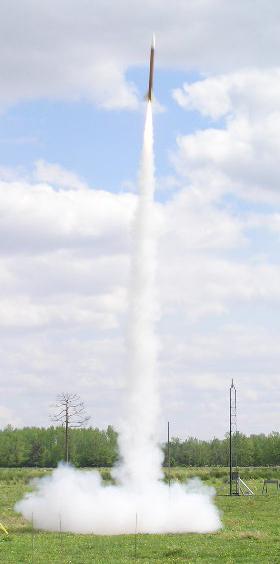| Construction Rating: | starstarstarstarstar_border |
| Flight Rating: | starstarstarstarstar_border |
| Overall Rating: | starstarstarstarstar_border |
| Manufacturer: | Loki |

Brief:
Loki's line of 38mm reloadable motors. Cheapest of the 38mm reloadable options
for both hardware and reloads. Currently, only the H144, I405, and J528 loads
(Loki White propellant) are available for these motors, but more formulas and
motor designations are coming out soon.
Construction:
Currently available is the Loki 240, 480, and 740 motor. Each motor comes with
a quality case with external snap ring (thrust ring), graphite nozzle, nozzle
washer, forward bulkhead, and snap rings. If you buy the system package, you
will get a forward closure for each motor. You don't have to share the closure.
A typical Loki reload comes with a spiral wound phenolic liner, propellant grains, delay grain, two large O-rings, six small O-rings, and a red cap (or vial) that contains 1.5 grams of black powder.
An interesting thing about the Loki reloads is the number of grains in the reload kit. The H144 uses 4 ~30 gram slugs, and the I405 (naturally) uses 8 ~30 gram slugs. The J528 breaks the trend, using six ~60 gram slugs. Loki's goal was to create loads that can be shipped parcel post, so they made the grains 30 grams. However, interesting things happened when the motors got too large using the smaller slugs, so this was not an option with the 740 motor.
 Assembling the Loki motor is very similar to Kosdon and AMW
motors. This is the order that I build them. I start out by greasing the two
large O-rings and placing them in the slot in the nozzle and bulkhead. Of
course it is important to make sure you use the correct nozzle for the load you
are using. The nozzle conveniently has a number scratched into the side that
corresponds to the reload instructions. Set the closures aside so they don't
get dirty, damaged, or lost.
Assembling the Loki motor is very similar to Kosdon and AMW
motors. This is the order that I build them. I start out by greasing the two
large O-rings and placing them in the slot in the nozzle and bulkhead. Of
course it is important to make sure you use the correct nozzle for the load you
are using. The nozzle conveniently has a number scratched into the side that
corresponds to the reload instructions. Set the closures aside so they don't
get dirty, damaged, or lost.
Then it is time to build the delay column. Simply stack the six smaller O-rings over the delay element then place it on a flat surface and press the forward bulkhead onto it so the delay grain goes into the delay well. I then use a blunt tool to push the O-rings in all the way.
Once this is done, you have the option of trimming the delay. It is a good idea to use the Loki-DAT tool for this. The Pro38 DAT tool would work also. Leaving the delay grain untrimmed will yield a 17 second delay. The DAT tool will allow you to trim it to 13, 10, 8, or 5 seconds.
Insert the forward part of the nozzle into the liner. Then stack in the propellant grains followed by the rear end of the forward closure. Grease up the inside of the case, and the liner tube. This will make the next step easier, and you will be thankful for the grease when it comes time to remove the spent components, trust me. Press the assembly into the motor case (nozzle should be at the end with the thrust ring) until the nozzle is about a quarter inch from the snap ring slot. Insert the nozzle washer, followed by the snap ring. Make sure the snap ring is in the groove by lightly squeezing the pliers and rotating the motor.
Turn the motor over and press down on the forward closure to press the nozzle and washer onto the snap ring. Install the final snap ring, making sure the snap ring is in the groove. Finish the motor construction by installing the ejection charge (if you want to use it). The forward closure gives you generous space for the ejection charge, so pour in as much as you need. Then take some wadding and place it on top of the charge. Then press on the red cap to hold everything in place. The wadding is there to hold the powder against the delay column.
Construction Rating: 4 out of 5

Flight:
To ignite the motor, I used a Magnelite igniter with a single fold. Ignition is
quick and the motor produces a bright white flame and tons of white smoke. Of
the two motors I flown, the I405 was my favorite! I had the pleasure to see
several I405 flights, and it has a loud and unique sound to it! After a launch
of a Big Brute with one, Carl Tulanko asked me, "What was that?" I
told him a Loki I405. Later on during the day, I had my PML Aurora loaded with
one and asked if he wanted to come to the flight line and watch it fly. He said
"No way! That motor is scary." It's a very impressive motor. I only
got to see one J528 flight up close. If you like the J350 and the J570, then
you would love this motor! Lots of umph!
Enjoy a video by clicking HERE
Recovery:
Cleaning of the Loki motor is identical to that of the AMW and Kosdon motors.
Remove the snap rings, and press on the bulkhead to press the components out of
the case. Suggested tool to use is a wooden dowel to push out the closure (or
nozzle, if you to use the other end). If you are fortunate (and remembered to
generously grease the liner), everything should come out with minor effort.
However, if the rocket had an impact of any kind, one of the bulkheads would
mash itself into the liner, making removal a chore. I used Baby wipes to clean
mine, which worked surprisingly well.
Flight Rating: 4 out of 5
Summary:
I am really pleased with the Loki 38mm product. I mentioned that it is cheaper
than other brands. Let's compare with this simple chart. Prices are retail list
and comparison is done with Aerotech White Lightning, Pro38 standard, and Loki
loads.
| AeroTech | Pro38** | Loki | |
|---|---|---|---|
| 240 motor | $92.95 | $32.95 | $49.99 |
| 240 reload | $19.99 | $30.75 | $19.99 |
| 480 motor | $106.95 | $49.15 | $59.99 |
| 480 reload | $35.95 | $43.95 | $29.99 |
| 720+ motor | $116.95 | $57.15 | $69.99 |
| 720+ reload | $47.95 | $57.15 | $39.99 |
** - Pro38 motor hardware is just a tube. There is no closures. In a sense, Pro38 motors are disposable motors that are held together by the case.
Another interesting comparison is the total impulse of the loads for the cases and how much they cost to fly per total impulse. This comparison based off data from the NAR/TRA/CAR combined list. All numbers have been rounded to nearest whole cent.
| Motor | Total Impulse (Ns) |
Cost per Ns |
|---|---|---|
| Aerotech H123 | 236 | 8 cents |
| Loki H144 | 239 | 8 cents |
| Pro38 H153 | 258 | 12 cents |
| Aerotech I211 | 435 | 8 cents |
| Loki I405 | 493 | 6 cents |
| Pro38 I285 | 510 | 9 cents |
| AeroTech J350 | 697 | 7 cents |
| Loki J528 | 741 | 5 cents |
| Pro38 J330 | 694 | 8 cents |
In the near future, Loki will be offering new loads for their motors. If you like fast burning, "kick 'em in the butt" loads, then you will enjoy their Blue Formula which will debut with a H294, I605, and my soon to be favorite, J1001! Also in the works are two moon burning loads that utilize their White formula. I can't wait to try out their I124 and J192 loads! Those loads have close to a 4 second burn!
What I would like to see in Loki's 38mm line is a 360 and 600 motor. I can imagine a 360 load priced at around $24.99 and a 600 load being a reasonable $34.99. I would also love to see Black and Spark loads introduced too. I would have the problem deciding which loads to buy!
Overall Rating: 4 out of 5
Other Reviews
- Loki Research 38mm Reload System By Lance Alligood
Brief: The Loki Research 38/480 motor casing and I405 reloads are perhaps the highest performance to lowest cost ratio of commercial 4-grain 38mm motors available on the market. If you are looking for colored flame reloads, then Loki Research motors may not be for you. Jeff Taylor of Loki makes no excuses about his products delivering nothing but the highest performance and motor effects be ...
 |
 |
J.M. (December 13, 2005)
L.A. (April 24, 2006)
R.J.K. (October 30, 2006)
Sponsored Ads
 |
 |












J.P.C. (July 17, 2005)